Secondo le più recenti indagini, la flora delle piante vascolari dei Colli Euganei comprenderebbe circa 1400 specie. Si tratta indubbiamente di un numero elevato, considerando la limitata estensione del complesso collinare; tra l'altro molte di esse un tempo erano presenti anche in numerosi distretti della pianura limitrofa, ma ora sono completamente scomparse. Un'escursione botanica sugli Euganei è, quindi, un'occasione ghiotta non solo per i botanici di professione, ma anche per i molti escursionisti della domenica che con una semplice passeggiata tra boschi e vegri possono scoprire piante e fiori rari e interessanti.
A parte i mesi più freddi, dicembre e gennaio, dalla fine dell'inverno sino al tardo autunno le fioriture si susseguono intense e ricche; già tra febbraio e marzo nei vigneti abbandonati si possono incontrare le dorate fioriture del Piè di gallo (Eranthis hyemalis), una rara ranuncolacea dalle foglie caratteristicamente laciniate. In quel periodo nei boschi i raggi del sole che penetrano attraverso i nudi rami degli alberi, pian piano riscaldano il terreno e alcune piante precoci cominciano a fiorire al margine dei boschi, lungo le siepi e nei vecchi coltivi. Qui, tra i primi Ellebori, i Bucaneve e gli Anemoni fiorisce la piccola rara Cipolla stellata (Gagea lutea) e nei recessi più umidi del bosco Daphne laureola spande il suo delicato profumo.
La bella Dentaria maggiore (Cardamine pentaphyllos), che vegeta nelle vallette più fresche e umide, è una specie tipica della faggeta; piccoli popolamenti relitti sono rimasti solo nei freschi castagneti di Rocca Pendice, a ricordo del passato di questi boschi, e le sue appariscenti e ricche fioriture ne coprono in aprile il sottobosco, mentre alla fine di marzo esso è già per ampi tratti coperto dal denso tappeto delle verdi e lucenti foglie dell'Aglio orsino (Allium ursinum); dopo poche settimane cominciano a sbocciare le grandi, globose infiorescenze di questa liliacea che, similmente ad una tardiva nevicata, trasformano il boschi in uno scenario fiabesco.
Come è ben noto, la flora euganea è particolarmente ricca di specie di habitat montani e alpini, considerate in molti casi dei relitti glaciali: un bell'esempio è la presenza di rari cespugli di Mirtillo (Vaccinium myrtillus), assai più diffuso negli ombrosi boschi di abeti montani. Inoltre, nei castagneti e nei querceti alla fine di maggio fioriscono pure il Giglio di San Giovanni (Lilium bulbiferum) e il bel Giglio martagone Lilium martagon); entrambe sono piante tipiche dei prati e dei pascoli di montagna dove fioriscono tra giugno e luglio.
Nel fitto del bosco vegetano poche orchidee, essendo la maggior parte di esse amanti della luce e particolarmente diffuse, come vedremo, nei prati e nei cespuglieti. Sui Colli Euganei una delle più rare è l'Orchide maschio (Orchis mascula), dai grandi fiori rosa carico; la possiamo incontrare solamente nei boschi di Rocca Pendice, del M. Venda e del M.Vendevolo e fiorisce alla fine di aprile.
La bella Orchide maculata (Dactylorhiza fuchsi) è pure poco diffusa; vive nelle stesse località della precedente oppure nei luminosi querceti e come questa fiorisce tra la fine di aprile e l'inizio di maggio. Sia prima che dopo la fioritura è riconoscibile per le foglie lanceolate, verde brillante e provviste di appariscenti macchie brune porpora.
Nei querceti e nei carpineti si trovano altre due rare specie di orchidee: l'Elleborina a foglie piccole (Epipactis microphylla) che per le modeste dimensioni e l'aspetto poco appariscente sfugge facilmente all'osservazione, e l'Elleborina di Müller (Epipactis muelleri) dalle verdi corolle pendule.
L'Iris susinaro (Iris graminea), dai grandi fiori violetti e dalle eleganti foglie nastriformi, non è molto comune e si può cercare ai margini erbosi dei boschi di querce. Piuttosto recentemente, in habitat analoghi è stata scoperta la splendida Peonia (Paeonia mascula) dai grandi fiori rosa carico. Autentica rarità della flora dei Colli Euganei, sino ad ora si conosce solamente una località in cui vegetano pochi, isolati esemplari.
Sui margini più soleggiati dei boschi, cresce sporadica la bella Centaurea di Triumfetti (Centaurea triumfetti), poco comune e presente solo sui rilievi centrali; essa è facilmente riconoscibile per la colorazione blu-viola dei suoi grandi capolini. Qui fiorisce anche la minuta Rosa cavallina (Rosa arvensis), dai fiori bianchi soffusi di rosa, che forma cespugli di modesta dimensione, con fioriture meno sgargianti e con portamento meno esuberante di quelle della più comune e nota Rosa di macchia (Rosa canina).
In ambienti simili, nelle radure luminose e sui pendii più aridi e assolati del M.Ceva e di pochi altri rilievi, l'accompagnano il Geranio sanguigno (Geranium sanguineum) e il Cisto a foglie di salvia (Cistum salvifolius), che formano delle caratteristiche cenosi piuttosto evidenti a maggio grazie alle ricche, ma effimere fioriture.
I vegri sono tra gli ambienti più tipici e più ricchi di fiori dei Colli Euganei. Essi si estendono sui pendii calcarei della parte meridionale del complesso, confinanti con i fitti ginestreti le cui luminose fioriture risplendono nelle belle e calde giornate di maggio spandendo nell'aria il loro intenso profumo. Qui fiorisce anche il Gladiolo dei campi (Gladiolus italicus), dalle fioriture rosa carico che spiccano nel verde pallido dell'erba.
Il prato arido è il regno delle orchidee, le cui fioriture si susseguono da marzo a ottobre.
I ricchi popolamenti dell'Ofride verde (Ophrys sphegodes), dell'Orchidea pagliaccio (Orchis morio) e dell'Orchidea scimmia (Orchis simia) compaiono ai primi di aprile, quando l'aria è ancora fredda e il cielo alle volte regala qualche acquazzone. Verso la fine di aprile o ai primi di maggio, sui pendii erbosi del M. Cecilia inizia a fiorire la rara Ofride del Benaco (Ophrys benacensis), a comparsa irregolare, abbondante in certe annate, rarissima in altre. Mentre nei vegri del M. Ceva vegetano la bella e rara Orchidea farfalla (Orchis papilionacea), dai grandi fiori scarlatti, e la strana Serapide maggiore (Serapias vomeracea). Entrambe iniziano a fiorire alla fine di aprile e, similmente ad altre orchidee, possono crescere abbondantissime oppure essere quasi completamente assenti.
La causa di questo comportamento è l'andamento della stagione invernale, delle sue temperature e soprattutto della quantità di pioggia autunno-invernale caduta sull'arido suolo.
Altre orchidee amano maggiormente il margine della macchia e l'ombra dei cespugli di ginestra, come la Vesparia (Ophrys apifera) e l'Ofride tutta di seta (Ophrys holoserica), mentre l'Elleborina bianca (Cephalanthera longifolia), una delle specie più comuni, è frequente anche in diversi altri ambienti. Alla fine dell'estate, tra le erbe rinsecchite e le rosse foglie dello scotano fiorisce infine la piccola e delicata Treccia di dama autunnale (Spiranthes spiralis).
Una delle specie più tipiche di questi luoghi prende il nome dalla città di Padova e rappresenta un'autentica rarità non solo del patrimonio naturale dei Colli Euganei, ma dell'intera flora italiana. Si tratta della Ruta padovana (Haplophyllum patavinum), descritta proprio su esemplari raccolti sugli Euganei, e più precisamente nella località di Sassonegro. In Italia questa rara specie è presente solamente sui pendii meridionali degli Euganei e la sua presenza al di fuori del territorio nazionale è concentrata nelle zone montuose della penisola Balcanica. Le sue gialle fioriture compaiono a maggio-giugno nelle nude aree d'argilla scagliosa.
Un ultimo accenno meritano le cenosi delle rupi di trachite; assolati e aridi, questi ambienti ospitano una interessante comunità vegetale dominata dall'esuberanza di una bella avventizia.
Ma bisogna salire questi luoghi di buon mattino per apprezzare le belle fioriture del Fico d'india nano (Opuntia humifusa); alla prima calura del giorno, infatti, i grandi e delicati fiori gialli si richiudono e appassiscono.
Questo piccolo cactus, originario dell'America centrale, fu importato in Europa nel XVII secolo, e la sua frugalità gli ha permesso di espandersi lungo tutte le Alpi meridionali; sulle rupi dei Colli Euganei esso cresce in competizione con un'altra pianta tipica di questi habitat rocciosi, il Semprevivo ragnateloso (Sempervivum arachnoideum), più ampiamente diffusa sui porfidi di vari gruppi montuosi veneti e trentini e che rappresenta un ricordo della flora che al tempo delle ere glaciali ricopriva le colline euganee.
According to recent investigations, the vegetation related to the vascular plants of the Euganean Hills would include approximately 1400 species. It is certainly a very high number, if you consider the limited extension of the hills; moreover, most of these species were once also present in many districts of the neighbouring plain, but today they completely disappeared. So, a botanical excursion around the Euganean Hills is a fascinating occasion not only for professional botanists but also for several hikers who, taking a simple walk among woods and abandoned vineyard can discover rare and interesting plants and flowers. Except for the coldest months of the year, December and January, by the end of the winter season up to the late autumn, abundant flowerings follow one after another and between February and March in the abandoned vineyards it is possible to come across the golden flowerings of the Winter-aconite (Eranthis hyemalis), a rare buttercup species with characteristic pronged leaves. In those days, the rays of sunshine coming in the woods through the bare branches of trees, slowly heated the ground and some early plants start blooming at the edge of the woods , along the hedges and in the old cultivated fields. Here, among the early Hellebores, the Snowdrops and the Anemones, the little rare Yellow Star of Bethlehem (Gagea lutea) blooms and in the deepest and dampest recesses of the wood the Spurge Laurel gives off its delicate fragrance. The beautiful Five Leaflet Bittercress (Cardamine pentaphyllos), which grows in the freshest and dampest hollows, is a species typical of the beech groves; it is possible to find only few small relicts in the fresh chestnut grooves of Rocca Pendice, in remembrance of the those woods past, in which its coloured and rich flowerings cover in April the undergrowth, while at the end of March it is mostly covered by the thick carpet of the green and bright leaves of the Wild Garlic (Allium ursinum); few weeks later, the big and globular inflorescences of this liliaceous plant start blooming and, similarly to a late snowfall, they change the wood into a fairy-tale scenery.
As is well known, the euganean plants are particularly rich of alpine and mountain habitat species, considered in many cases glacial relicts: a good example is the presence of rare bushes of Blueberry (Vaccinium myrtillus), mostly common in the shady mountain fir woods. Furthermore, the chestnut and the oak groves see the flowering, at the end of May, of the Orange Lily (Lilium bulbiferum) and of the beautiful Martagon Lily (Lilium martagon); both are plants typical of the mountain meadows and pastures where they bloom between June and July.
In the thick of the wood few orchids grow, as most part of them, they love the light and they are particularly common, as we will see, in the meadows and in the bushes. One of the rarest orchids of the Euganean Hills is the Early Purple Orchid (Orchis mascula), with its big strong pink flowers; it is possible to see this flower only in the woods of Rocca Pendice, of the M. Venda and of the M. Vendevolo and it blooms at the end of April. The beautiful Common Spotted Orchid (Dactylorhiza fuchsi) is also less common; it grows in the same place of the previous orchid or in the bright oak groves and it also blooms between the end of April and the beginning of May. Both before and after the flowering it is recognizable for its lanceolate leaves, bright green and with striking purple spots.
In the oak groves it is also possible to find other two rare species of orchids: the Small-leaved Helleborine (Epipactis microphylla) which, because of the small size and the slightly striking look, easily escape the attention, and the Muller's Helleborine (Epipactis muelleri) with the green "hanging" corollas.
The Iris (Iris graminea), with big violet flowers and elegant ribbon-like leaves, is not very common and it is possible to find it in the oak groves grassy edges. Quite recently, in similar habitats it has been discovered the wonderful Peony (Paeonia mascula) with big strong pink flowers. Authentic rarity of the Euganean Hills plants, it is known only one place in which few and isolated specimens grow. On the brightest sides of the woods, the beautiful Knapweed of Triumfetti (Centaurea triumfetti) sporadically grows, not too much common and only present on the central mountains; It is easily recognizable for the blue-violet colours of its big inflorescences. The little Field Rose (Rosa arvensis) also blooms in this places, with white flowers stained with pink, which create bushes of small size, with flowerings less sparkling than those of the most common and known Dog Rose (Rosa Canina). In similar environments, in the bright glades and on the driest and sunniest slopes of the M. Ceva and few other mountains, it is also possible to find the Bloody Cranesbill (Geranium sanguineum) and the Sage-Leaved Cistus (Cistus salvifolius), which create characteristic coenoses almost evident in May thanks to the rich but ephemeral flowerings.
The abandoned vineyards are among the most typical and full of flowers environments of the Euganean Hills. They spread along the chalky slopes of the southern side of the complex of mountains, bordering on the thick brooms whose bright flowerings shine in the beautiful and hot days in May giving off their intense fragrance. Also the Field Gladiolus (Gladiolus Italicus) blooms here, with its strong pink flowerings which stand out in the pale green grass. The dry meadows are the kingdom of orchids, whose flowerings follow one after another from March to October.
Rich groups of the Early Spider Orchid (Ophrys sphegodes), the Green-winged Orchid (Prchis morio) and the Monkey Orchid (Orchis simia) appear at the beginning of April, when the air is still cool and the sky sometimes still gives some downpours. At about the end of April or the beginning of May, on the grassy slopes of the M, Cecilia the rare Yellow Ophrys (Ophrys benacensis) start blooming, with an irregular appearance, some years they are very copious, and other years they are very rare. In the abandoned vineyards of M. Ceva instead, the beautiful and rare Pink Batterfly Orchid (Orchis Papilionacea), with the big scarlet flowers, and the strange Long-lipped Serapias (Serapias vomeracea) grow. Both start blooming at the end of April and, similarly to other orchids, can abundantly grow or be almost completely absent. This is caused by the course of the winter season, by its temperatures and above all by the number of Autumn-Winter rains fallen on the dry ground.
Other orchids mostly love the edge of the wood and the shadow of the broom bushes, such as for example the Bee Orchid (Ophrys apifera) and the Late Spider Orchid (Ophrys holoserica), while the Sword leaved Helleborine (Cephalanthera longifolia), one of the most common species, is also frequent in other different environments. At the end of the summer season, among the withered leaves of grass and the red leaves of the wig tree, finally the small and delicate Autumn Lady's Tresses (Spiranthes spiralis) blooms. One of the most typical species of these places takes the name from the city of Padua and represents an authentic rarity not only for the natural heritage of the Euganean Hills, but of the entire Italian flora. We are talking of the Ruta Patavina (Haplophyllum patavinum), described on specimens collected on the Euganean Hills, and to be more precise in the whereabouts of Sassonegro. In Italy this is a rare species which is possible to find only on the southern slopes of the Euganean Hills and its presence out of the National territory is concentrated in the mountain areas of the Balkan Peninsula. Its yellow flowerings appear in May-June in the bare scaly clay areas. Finally, the coenoses of the trachyte cliffs deserve to be mentioned; these sunny and dry environments contain an interesting plant community, controlled by the exuberance of a beautiful occasional plant. But it is necessary to raise these places early in the morning in order to appreciate the beautiful flowerings of the Prickly Pear (Opuntia humifusa); in fact, in the first heat of the day, the big and delicate yellow flowers close and wither. This small cactus, coming from the central America, has been imported in Europe in XVII century, and its "frugality" allowed it to grow along all the southern Alps; it grows on the Euganean Hills cliffs together with another plant typical of these rocky habitats, the Cobweb Houseleek (Sempervivum arachnoideum), widely common on the porphyries of several mountain groups of Veneto and Trentino which represents a memory of those plants which during the Ice ages covered the Euganean Hills.
|


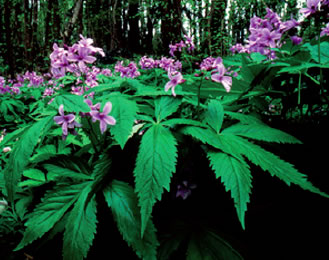
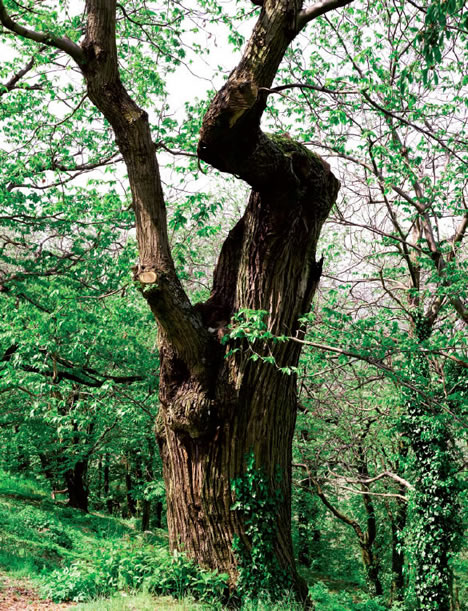
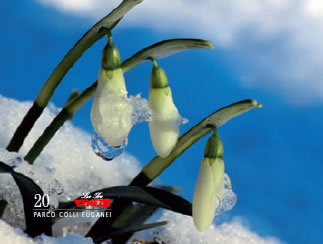
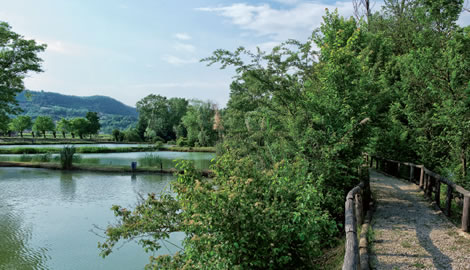
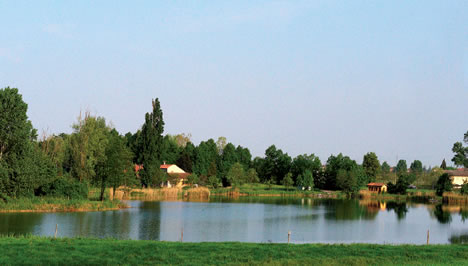


|











